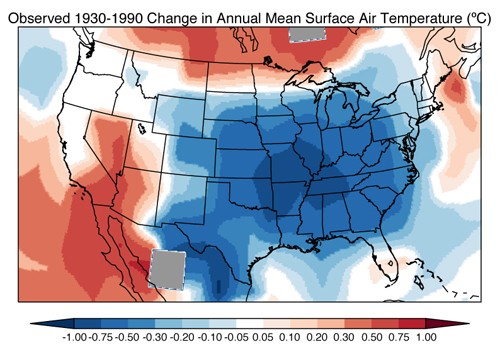Pollution caused global warming hole delayed climate change over eastern United States

Fig. 1. Observed change in surface air temperature between 1930 and 1990. Temperature change is based on the linear trend as in Hansen et al. (2001). Observations are from the NASA GISS Surface Temperature Analysis (Credit: E.M. Leibensperger et al 2012 Creative Commons)
"What we've shown is that particulate pollution over the eastern United States has delayed the warming that we would expect to see from increasing greenhouse gases," said lead author Eric Leibensperger in a media release. "For the sake of protecting human health and reducing acid rain, we've now cut the emissions that lead to particulate pollution, but these cuts have caused the greenhouse warming in this region to ramp up to match the global trend."
Environment regulations like the Clean Air Act enacted in 1970, and refinements passed in 1990 have resulted in major decreases in particulates and sulphur dioxide pollution in the atmosphere in the region. Sulphur Dioxide combines with water in the atmosphere to cause acid rain which was causing dieback of ecosystems and forests and damage to buildings. Particulate pollution also causes human health problems.
The abstract says in part:
We find that the regional radiative forcing from US anthropogenic aerosols elicits a strong regional climate response, cooling the central and eastern US by 0.5-1.0 °C on average during 1970-1990, with the strongest effects on maximum daytime temperatures in summer and autumn. Aerosol cooling reflects comparable contributions from direct and indirect (cloud-mediated) radiative effects. Absorbing aerosol (mainly black carbon) has negligible warming effect. Aerosol cooling reduces surface evaporation and thus decreases precipitation along the US east coast, but also increases the southerly flow of moisture from the Gulf of Mexico resulting in increased cloud cover and precipitation in the central US. Observations over the eastern US show a lack of warming in 1960-1980 followed by very rapid warming since, which we reproduce in the GCM and attribute to trends in US anthropogenic aerosol sources.
Pollution controls have reduced the global warming hole effect substantially in the last twenty years, with perhaps a third of a degree C still to recover. The researchers say that pollution aerosols are low enough now that future air quality improvements are not likely to cause little further warming in the US (0.1 °C over 2010-2050). "We find that most of the warming from aerosol source controls in the US has already been realized over the 1980-2010 period."
There is a major lesson here for other regions, like China and India, with a high degree of particulate pollution. If the pollution is tackled, this will result in cleaner air and reduced human health problems, but more prounounced global warming.
"The primary driver of the warming hole is the aerosol pollution - these small particles," says Leibensperger. "What they do is reflect incoming sunlight, so we see a cooling effect at the surface."
Particulates are short term pollutants that stay in the atmosphere for about a week before they are washed out. But while they are in the atmosphere interactions between clouds and particles amplify the cooling. Pollution particles can act as catalysts for clouds resulting in reflection of even more sunlight than the particles would individually, leading to greater cooling at the surface.
While global warming has increased temperatures on average across the globe by 0.8C in the hundred years from 1906 to 2005, temperatures in the warming hole over central and eastern USA decreased by as much as 1.0 degree Celsius during the period 1930-1990. With the clean air regulations and reductions in particulate pollution the cooling effect has been reduced to about 0.3C in 2010.
"Such a large fraction of the sulfate has already been removed that we don't have much more warming coming along due to further controls on sulfur emissions in the future," says principal investigator Daniel Jacob, the Vasco McCoy Family Professor of Atmospheric Chemistry and Environmental Engineering at SEAS.
Study co-author Loretta J. Mickley, a Senior Research Fellow in atmospheric chemistry at SEAS, warned that a similar global warming hole could be ocurring over China. "Something similar could happen in China, which is just beginning to tighten up its pollution standards. China could see significant climate change due to declining levels of particulate pollutants."
"No one is suggesting that we should stop improving air quality, but it's important to understand the consequences. Clearing the air could lead to regional warming," Mickley says.
More problematic are the greenhouse gases such as Carbon Dioxide which can stay and accumulate in the atmosphere for hundreds of years. While reduction of particulate emissions has occurred from coal fired power stations, the CO2 has continued to be pumped into the atmosphere adding to the greenhouse effect and global warming.
The research was based on two complex model systems which incorporate data for several decades. The pollution data comes from the GEOS-Chem model, first developed at Harvard which has become an international standard for modeling pollution over time. The climate data came from the general circulation model developed by NASA's Goddard Institute for Space Studies.
Sources:
- Adapted from Media Release, Harvard University, School of Engineering and Applied Sciences, April 26, 2012 - "Warming hole" delayed climate change over eastern United States
- E. M. Leibensperger, L. J. Mickley1, D. J. Jacob, W.-T. Chen, J. H. Seinfeld, A. Nenes, P. J. Adams, D. G. Streets, N. Kumar, and D. Rind, Atmospheric Chemistry and Physics, Climatic effects of 1950-2050 changes in US anthropogenic aerosols - Part 2: Climate response, abstract, Full paper PDF, doi:10.5194/acp-12-3349-2012,
- Images from Full paper reproduced under Creative Commons Attribution 3.0 License.
Get Involved
If you'd like to help with maintaining or developing the website, contact us.
Publish
Publish your stories and upcoming events on Indybay.


